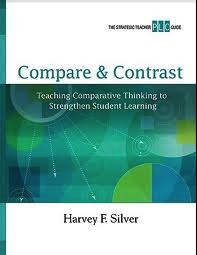Teaching Comparative Thinking
Compare & Contrast: Teaching Comparative Thinking to Strengthen Student Learning
by Harvey F. Silver
(ASCD, 2010 – Learn more)
Reviewed by Joni Allison
Billed as “a new kind of professional development tool,” Harvey F. Silver’s series of Strategic Teacher PLC Guides provide teachers and administrators with his solution to the question How do we make our professional learning communities work? Through these guides, Silver provides a workbook for a group of 4 to 8 teachers to build what he calls a learning club.
Silver introduces and explains the guidelines to creating an effective learning club that will —

Learn new strategies interdependently
Use new strategies in their classrooms
Bring student work back to their learning clubs
Self-assess throughout the process
The rest of Compare and Contrast: Teaching Comparative Thinking to Strengthen Student Learning (which is divided into 4 sections) focuses on helping teachers integrate the compare and contrast strategy into their classroom practice. Silver encourages teachers to reflect on their own thinking, learning, and classroom practice throughout the book.
Section 1: Explains and Justifies the Use of the Compare and Contrast Strategy
Teachers begin by learning the rationale and expected outcomes of implementing comparing and contrasting into classroom lessons. Silver includes samples of students’ work that demonstrate comparative thinking. He concludes the section with his delineation of the compare and contrast strategy (description, comparison, conclusion, application) by offering a model lesson of the strategy in action in a high school classroom. This process is also artfully summarized on a poster included in the guide that teachers can use in their classrooms.
While I found the information in section 1 to be common knowledge for many teachers I work with, I do think a team of interdisciplinary teachers could use it to discuss how to implement a single strategy across their multiple disciplines.
Section 2: Coaches Teachers in Planning a Compare and Contrast Lesson
Teachers complete a jigsaw reading of four sample lesson plans. Then, working with a partner, teachers plan their own compare and contrast lesson plan. Again the lesson planning structure should not be novel to a veteran teacher. However, the new insight I took away from this section was incorporating the Habits of Mind, listed in Appendix B, into each lesson.
I loved the purposeful and meaningful application that including the Habits of Mind brings to a lesson – teachers plan for how students will use the knowledge, the understanding, and the skills acquired during instruction, beyond the classroom. (For more information on the Habits of Mind, Silver encourages readers to visit www.instituteforhabitsofmind.com.)
Another strategy I enjoyed in section 2 is Q-SPACE (like any good educator, I crave a new acronym) which sums up techniques teachers should use when leading a classroom discussion. Especially important is the S, silence or wait time for students to think. That’s something many of us struggle with in our high-stakes, high-pressure classrooms of the 21st century.
Section 3: Guides Teachers to Evaluate a Lesson
Before completing section 3, teachers invite a colleague into their classroom to observe the delivery of the lesson planned in section 2. The Strategic PLC Guide provides observation, discussion, and sharing guidelines to help teachers reflect and refine their implementation of the compare and contrast strategy.
I find myself comparing Silver’s idea — creating a “critical friend” to collaborate and reflect on your teaching practice — to superficial colleague walk-throughs or evaluative observations of administrators. I would welcome the opportunity to sharpen my craft through the informed, focused, and effective feedback from a fellow teacher that I trust and respect.
Section 4: Analyzes Student Work
The Compare and Contrast PLC Guide concludes with teachers designing a second Compare and Contrast lesson and collecting samples of student work to analyze with a rubric. I agree that this is an invaluable part of the reflecting process. However, I was disappointed that teachers are not encouraged earlier to create and share the rubric with their students. Or better yet, involve students in the creation of the rubrics.
A place to begin
When I finished reading the Compare and Contrast Strategic PLC Guide, I found myself disappointed in the lack of academic rigor in the classroom examples and the amount of professional engagement this PLC guide would provide. There simply isn’t enough material for more than eight or nine weeks of consideration. And then what? Do teachers continue the PLC by buying another Strategic Guide or do they apply what they learned about the PLC process to another topic or strategy? I also kept wondering: Would this PLC guide truly challenge my faculty, which has many National Board Certified teachers?
That being said, this approach is not without strengths. The book makes creating a PLC approachable and troubleshoots one of the greatest obstacles to educators who attempt to create a PLC: Time. The Strategic Teacher PLC Guide does it all for you. It provides clear delineation of the compare and contrast process, and I can see myself applying this same systematic approach to other higher-order thinking skills.
So much of the Strategic PLC process reminds me of my year completing my National Board Certification, where reflection is a constant. Silver’s process creates a way to align NBPTS’s reflective process with a collaborative learning community. I think that if you and your colleagues are looking for an easy first step in establishing a collaborative PLC, you might want to take a look at Silver’s Strategic Teacher PLC Guides and find a strategy that you would like to add to your teaching repertoire.
Joni Allison is a National-Board certified ESOL teacher in Henderson County, NC where she teaches a sheltered high school social studies course and co-teaches language arts and social studies classes in grades 6-8. In the summer of 2012, she became a National Endowment for the Humanities Scholar in studying the land, culture, and history of Appalachia. She tweets @JoniAllison23.



































